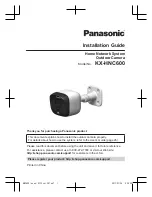
Integrated Smart Sensor and Photocell
Cat. No. ZLD1Z-I0W
INSTALLATION INSTRUCTIONS
ENGLISH
DI-000-ZLD1Z-02A
WARNINGS
• TO AVOID FIRE, SHOCK, OR DEATH: TURN OFF POWER AT CIRCUIT BREAKER OR
FUSE AND TEST THAT POWER IS OFF BEFORE WIRING!
• To be installed and/or used in accordance with appropriate electrical codes and regulations.
CAUTIONS
• For indoor or outdoor applications.
Product Description
The Leviton Integrated Smart Sensor and Photocell uses Bluetooth™ 5.0 technology for
configuration. It is designed for use with Switching or 0-10V LED Drivers and Fluorescent
Ballasts and uses Passive Infrared (PIR) detection technology to monitor a space for
occupancy using advanced lenses. The specialized lenses provide extended Field-of-View
(FOV) for low-mid bay and mid-high bay applications.
Leviton's Integrated Smart Sensors combine multiple sensors and technology to provide
lighting control automatically and efficiently. Occupancy sensors turn the lights
ON—and keep them ON—while the space is occupied and turns them OFF when the space
is vacant, and the delayed-off timer has expired. Photocell detects natural light and dims
lighting up or down as needed for additional energy efficiency and occupant comfort benefits.
The sensor continually analyzes and adjusts to ensure adequate lighting under
varying conditions.
1.
WARNING:
TO AVOID FIRE, SHOCK, OR DEATH, TURN OFF POWER at circuit breaker or fuse
and test that power is off before wiring!
Installation
Wiring Diagram
3.
Install the sensor.
a.
The sensor is designed to be installed through a 1.3 in. diameter hole in material up
to 0.125 in. thick. Use lock nut to further secure controller, if needed.
b.
Remove the nut from the lens tube.
c.
Install sensor through hole and tighten nut to no more than 15 lb.-in.
d.
Install lens by lining up the mark on the lens 45
°
counterclockwise from the near end of
the sensor and rotating it 45
°
clockwise to lock it in place.
e.
Install optional mask (if required) by aligning the marks on the lens and mask and
rotating the mask.
f.
Restore power at circuit breaker or fuse.
NOTES:
• Allow approximately 30 seconds for start-up. If the lights turn ON and the LED blinks when a
hand is waved in front of the lens, then the sensor was installed properly. If the operation is
different, refer to the Troubleshooting section.
• The sensor is preset to work without any adjustments. If you would like to change the
factory settings, refer to the Configuration section.
SPECIFICATIONS
Input Voltage/Frequency 120-277 VAC, 50/60 Hz
Input Current
Max 15 mA
Standby 8 mA
Load Ratings
LED, Electronic Ballast, General Use @ 120V 6.7 A
LED, Electronic Ballast, General Use @ 230V 4.4 A
LED, Electronic Ballast, General Use @ 277V 4.4 A
Resistive, Tungsten @ 120V 800 W
Resistive, Tungsten @ 230V 1000 W
Resistive, Tungsten @ 277V 1200 W
Motor @ 120 - 277V 1/6 hp
0 -10V Dimming Control 50 mA MAX (sinking)
Terminal Torque Rating 2.6 lb.-in. (0.3 Nm)
Environmental Rating IP66* (Type 3R)
Network Connections Bluetooth 5.0
Operating Temperature -40 °F to 167 °F (-40 °C to 75 °C)
Storage Temperature -40 °F to 185 °F (-40 °C to 85 °C)
Relative Humidity 0% to 90% RH, Non-Condensing
Purpose of Control Energy Management Equipment
Pollution Degree 2
Impulse Voltage 4000V
Action Control Type 1
Dimensions
Width: 1.39 in. (35.3 mm)
Length: 3.75 in. (95.3 mm)
Depth: 0.91 in. (23 mm)
* When installed in an appropriate IP66 rated enclosure/fixture.
For Optimal Performance:
The ZLD1Z-I0W sensor lenses establish dozens of zones of detection. The sensor is
sensitive to the heat emitted by the human body. In order to trigger the sensor, the source
of heat must move from one zone of detection to another. The device is most effective in
sensing motion across its field-of-view, and less effective sensing motion directly towards or
away from the sensor. Keep this in mind when selecting the installation location. Note that
occupancy sensors respond to rapid changes in temperature, so care should be taken NOT
to mount the device near a climate control source (i.e., radiators, air exchanges, and air
conditioners). Hot or cold drafts will register as body motion to the device and will trigger it if
the unit is mounted too close. It is recommended to mount the occupancy sensor at least 6 ft
away from a climate control source.
Tools Needed:
• Wire Stripper
• Cutters
• #0 Slotted Screwdriver
Parts Included:
• Fixture Sensor (1)
• Low/Mid Bay Lens (1)
• High Bay Lens (1)
• Gasket/Rubber Flat Washer (1)
• Lock Nut (1)
• Aisleway Mask Cover (2)
2.
Prepare and connect wires. Refer to the appropriate wiring diagram.
For 0-10V Control Wiring: Connect the VIOLET wire to the 0-10V DIM (+) terminal and
the GRAY or PINK wire to the 0-10V DIM (-) terminal using Class 1 or Class 2 wiring
methods as indicated in these instructions, ballast/fixture/driver instructions, or ballast/
fixture/driver label markings. Observe all requirements of any authority having jurisdiction
with respect to wire type, sleeving, isolation methods, and the like.
LIGHTING
LOAD
LIGHTING
CIRCUIT
LINE FEED
WHT
BLU
VIO
PNK
LINE
Internal Single Relay
Fixture Mount Sensor
NEUTRAL
FIELD OF VIEW
Mounting Height
(Ft.)
Field of View Lens
Major
(Sq. Ft.)
Minor
(Sq. Ft.)
8
Low Bay
2050
900
15
Low Bay
1750
750
20
Low Bay
1850
350
20
High Bay
2300
1050
30
High Bay
5300
800
40
High Bay
8250
550




















